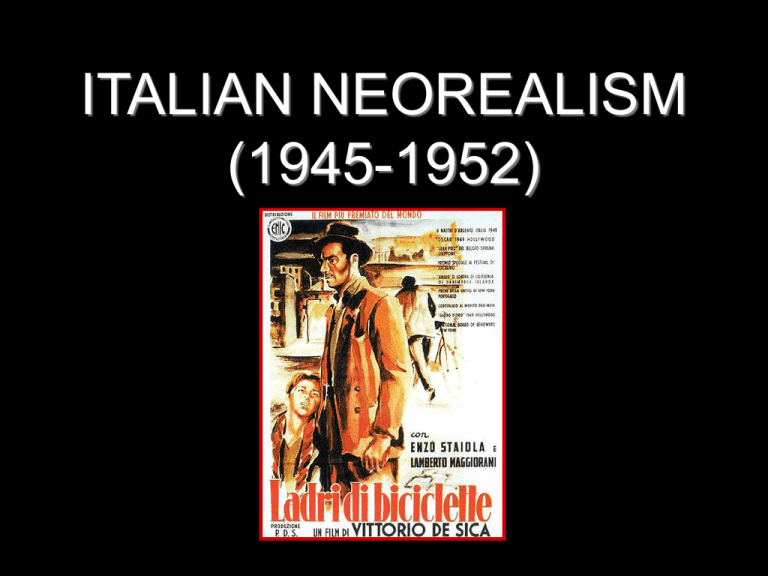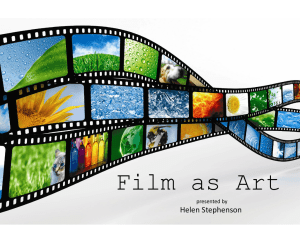OPEN CITY
advertisement

ITALIAN NEOREALISM (1945-1952) What is Neorealism A film movement, developed in Italy in the final years of World War 2, which was based on reality, looked at the reality with both a simple and critical eye, trying to interpret how life and human beings really are. 1. Historical 2. Documentary 3. Technical 4. Critical Historical context • Italy in the aftermath of World War II • Nazi occupation • Partisan Resistance • A country devastated by the war → Destruction Poverty Unemployment In a state of physical and spiritual ruin, Italy produced one of the most important and influential moments in the history of cinema. A revolution in style and content. Italian cinema under Mussolini • No direct use of film for propaganda • A cinema of distraction, whose primary goal was to entertain and project a falsely optimistic picture of Italian society: “Calligraphism” → Costume melodramas “White telephone films” → Romantic comedies • Plot, formulas and conventions similar to those of the classical Hollywood film • CENTRO SPERIMENTALE DI CINEMA (1935) The official film school • CINECITTA’ (1937) The biggest film studio in Europe Neorealist cycle ROMA CITTA’ APERTA (Open City) Roberto Rossellini, 1945 UMBERTO D Vittorio De Sica, 1952 Neorealist revolution Ideology • To expose the poverty and the social malaise of a postwar Italy in shambles • To tell stories that take place in the present day • To focus on the life of the lower classes • To present problems that derive less from the protagonists’ inner psychological conflicts than from external social conditions • To adopt a compassionate point of view and a refusal to make easy moral judgements • To emphasize emotions over abstract ideas Neorealist revolution Aesthetics • Documentary visual style • Location shooting • Post-synchronized sound • Mobile camera • Non-professional actors • Unobtrusive direction • Avoidance of artifice in editing, camerawork and lighting Neorealist revolution Narrative • Avoidance of carefully plotted stories • Episodic structures that evolve slowly and organically • No solution offered at the end of the film A film should present life as it is; the viewer feel the need for working at solutions. The moviegoer is the real hero of life, the true protagonist of life. When we see a film, we must identify ourselves with what we are, rather being alienated from our true selves by fictional escapism. An artistic and moral philosophy Key figures of Neorealism Roberto Rossellini (1906-1977) Vittorio De Sica (1901-1974) Luchino Visconti (1906-1976) Cesare Zavattini (1902-1989) Political leftists, who blended Christian and Marxist humanism to create a socially engaged national cinema Zavattini’s theory A cinema without “stories” (from Some Ideas on the Cinema, 1953) “The most important characteristic, and the most important innovation, of what is called Neorealism, is to have realised that the necessity of the ‘story’ was only an unconscious way of disguising a human defeat, and that the kind of imagination it involved was simply a technique of superimposing dead formulas over living social facts. Now it has been perceived that reality is hugely rich, that to be able to look directly at it is enough; and that the artist’s task is not to make people moved or indignant at metaphorical situations, but to make them reflect (and, if you like, to be moved and indignant too) on what they and others are doing, on the real things, exactly as they are.” Zavattini’s theory A narrative without “causality” (from Some Ideas on the Cinema, 1953) “To begin with, while the cinema used to make one situation produce another situation, and another, and another, again and again, and each scene was thought out and immediately related to the next (the natural result of a mistrust of reality), today, when we have thought out a scene, we feel the need to ‘remain’ in it, because the single scene itself can contain so many echoes and reverberations, can even contain all the situations we may need. Today, in fact, we can quietly say: Give us whatever ‘fact’ you like, and we will disembowel it, make it something worth watching.” Open City (1945) About the collaboration of a Catholic priest and Communist partisans fighting Nazi occupation of Rome shortly before the American army liberated the city. Filmed secretly between 1943 and 1945, on a very low budget, using poor quality film stock, bought on the black market in bits and pieces. Use of real footage of German troops in the final days of their occupation. Shortage of electrical power, which made maintaining consisting exposure a problem. Self-financed, with many difficulties. Open City Highlight the dignity of ordinary people in the face of great adversities, and their heroism in a daily fight for freedom. HOPE that is never superficial optimism. COMPASSION that is never sentimentalism. Rossellini’s method “In a classical fictional film, it may be right to work with an ‘iron’ script. But in a neorealist film, which raises questions and seeks for the truth, you can’t adopt the same method. Here the inspiration plays the most important part. I meditate upon the subject of my films for a long time. Then I write a script, because it would be absurd to invent everything at the last minute. But all the scenes, the dialogue and even the setting are changed and adapted day by day. I hate the ‘logical link’ of the story. When I feel that what I am shooting is important for the ‘continuity’, rather than for what I really want to express, then I don’t know how to deal with it. On the other hand, when a scene is really essential to my inspiration, everything becomes easy.” Rossellini’s method “It’s correct to say that in every film I make I am only really interested in one particular scene, the ending for example, which I have already in my mind. For the last part of Paisà [Paisan 1946] I had thought about those corpses that slowly flowed on the waters of the river Po, carrying a sign with the word ‘Partisan’. The river has brought those corpses for months. You could see many of them on a same day. And Germania Anno Zero [Germany Year Zero 1948], to be honest, was made just because of the final scene of the child who wanders alone among the ruins. I didn’t care much about what was before in the film.” Paisan (1946) In six separate episodes, the film outlines the Allied campaign to liberate Italy from the Nazi occupation, shows the suffering of the people and draws attention to the violence of the invaders. Each episode sketches one aspect of the complex and changing American-Italian relationships, which move from initial distrust to growing closeness. Semi-documentary style: the camera and editing techniques are totally unremarkable and they only serve to present ‘the facts’. Of the large cast, only four members had previous acting experience; all the others were chosen by Rossellini as he found them on location. Germany Year Zero (1948) A highly dramatic and bitter portrait of Germany after the war, with its cities destroyed, its families mourning, its young people poisoned by the Nazi ideology and its society lost and abandoned. Edmund, the young protagonist, wishes to die after his father’s death. Lonely, with no love from his family and his innocence threatened by an indifferent world, he is at the same time the victim and the symbol of a country on its knees. A film with an implicit message of reconciliation and against the absurdity of war, which uses the tragedy of a child as a metaphor for all that has been sacrificed to the cult of violence, intolerance and hatred under Hitler’s regime. Childhood OPEN CITY (1945) PAISAN (1946) GERMANY YEAR ZERO (1948) Rossellini’s “Trilogy of the war” SHOESHINE (1946) THE BICYCLE THIEF (1948) Themes: Lost innocence and early maturation Learning and understanding Children are victims of the war, either directly, or because witnesses of acts of brutality, or because forced to live a hostile reality and to pay for the errors of the adults. Children are also the only possible way to a better future, the only hope to move toward a world of solidarity, social justice and peace. Andre Bazin on Neorealism Une esthétique de la Réalité: le néo-réalisme (1948) • Revolutionary adherence to the actuality of life. • Maintaining the ambiguity of reality through the use of long shots and the avoidance of the analytical editing associated with the découpage of classical Hollywood cinema. • Demonstrating how realism in cinema has a highly aesthetical connotation. • Challenging the traditional notion of cinema as ‘neutral spectacle’ by making it utterly dependant, in style and narrative, on the historical and social context in which the films are made. The legacy of Neorealism EUROPEAN MODERN CINEMA Fellini Antonioni Bresson FRENCH NOUVELLE VAGUE Truffaut Godard NEW HOLLYWOOD Scorsese Cassavetes Coppola Ambiguities of Neorealism • No exclusive use of non-professional actors: LA TERRA TREMA (1948) A small town of fishermen in Sicily Completely spoken in Sicilian dialect OPEN CITY (1945) Anna Magnani Aldo Fabrizi • No exclusive use of location shooting • Combination of ‘real life’ and ‘facts’ with melodrama • Use of cause/effect and goal-oriented plots as in Hollywood cinema International Prizes OPEN CITY Grand Prize at the Cannes Film Festival Best Foreign Language Film for the New York Film Critics Circle Nominated for the Best Screenplay Oscar SHOESHINE Nominated for the Best Screenplay Oscar Best Foreign Language Film Oscar (Honorary Award) PAISAN Best Foreign Language Film for the New York Film Critics Circle Best Foreign Language Film for the National Board of Review Nominated for the Best Screenplay Oscar GERMANY YEAR ZERO Grand Prix at Locarno Film Festival Best Screenplay at Locarno Film Festival THE BICYCLE THIEF Best Foreign Language Film Oscar Nominated for the Best Screenplay Oscar Best Foreign Language Film at Golden Globes Special Prize of the Jury at Locarno Film Festival Best Picture and Best Director for the National Board of Review Best Foreign Language Film for the New York Film Critics Circle LA TERRA TREMA Nominated for the Golden Lion at the Venice Film Festival UMBERTO D Nominated for the Best Screenplay Oscar Nominated for the Grand Prize at the Cannes Film Festival Best Foreign Language Film for the New York Film Critics Circle The Bicycle Thief (1948) “De Sica’s is the art which conceals art. His style calls attention, not to itself, but to the subject.” (Murray) “When we read its summary, the story of many Italian films can’t help but being ridiculous. And yet in these films all the characters exist with an astonishing truth.” (Bazin) Depicts an Italy of poverty and desperation, but without using an iconography and narrative directly based on the war • Location shooting (interiors and exteriors) • Non-professional actors (protagonists and extras) • ‘Inconspicuous’ direction, shot compositions, camerawork, lighting • The need for human solidarity • The contrast between individual and society • The father / son relationship The Bicycle Thief (1948) Synthesis of Neorealism with the classical Hollywood film: • Motivation • Exposition + Hermeneutic Sentence • Invisible editing For De Sica and Zavattini, Neorealism is above all a strongly humanist and reformist impulse.







